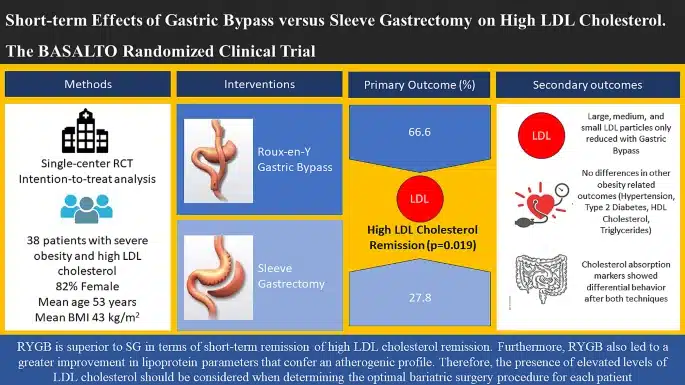The main objective of the study was to determine whether high levels of LDL cholesterol should be considered when selecting the most appropriate bariatric surgical procedure for each patient. Additionally, the study aimed to compare the remission of LDL cholesterol 12 months after RYGB and SG. As well as examine the evolution of other obesity-related complications, weight, and conventional lipid profiles.
For this purpose, in the phase 3 randomized clinical trial called BASALTO (NCT03975478), 38 patients with severe obesity and elevated levels of LDL cholesterol were randomly assigned to undergo either RYGB or SG.
The primary outcomes focused on the remission of LDL cholesterol, defined as LDL levels < 3.36 nmol/l without lipid-lowering medications.
Additionally, the LIPOSCALE® test was used in the study to characterize the different lipoprotein fractions using nuclear magnetic resonance (NMR) spectroscopy. This allowed for the determination of cholesterol and triglyceride content in the main lipoprotein fractions (VLDL, IDL, LDL, and HDL) in plasma. As well as measuring the particle concentration (total, large, medium, and small) of each main fraction and the size of the main lipoprotein fractions.
Study results demonstrated that 67% of patients who underwent RYGB had normalized LDL cholesterol levels at 12 months, compared to 28% of patients who underwent SG. Furthermore, the use of the LIPOSCALE test provided a detailed understanding of the qualitative changes in the lipoprotein profile of patients after undergoing the described procedures. Patients who underwent RYGB showed a significant reduction in large, medium, and small LDL particles.
Regarding cholesterol absorption markers, there was differential behavior after both procedures. For example, campesterol decreased after RYGB and increased after SG.
The authors of the study explain that the intervention in both the stomach and the intestine in gastric bypass is key to its effectiveness, as it reduces cholesterol absorption into the bloodstream. Dr. David Benaiges, head of the Endocrinology section at Hospital del Mar, highlights that “the choice between one technique and the other has lifelong implications for the patient.” Thus, the study results suggest that “having high LDL cholesterol before surgery should be a new criterion for consideration by the medical team.”
Dr. Benaiges proposes “including LDL cholesterol levels in clinical guidelines.” The bypass not only improves obesity but also protects the patient’s cardiovascular health. Meanwhile, Dr. Juan Pedro-Botet, co-author of the study, emphasizes that bariatric surgery is one of the most effective tools not only for weight loss but also for its cardiovascular benefits.
The study concludes that Roux-en-Y gastric bypass (RYGB) is superior to sleeve gastrectomy (SG) in terms of short-term remission of elevated LDL cholesterol levels. Additionally, RYGB led to greater improvement in lipoprotein parameters that confer an atherogenic profile. Therefore, the presence of elevated LDL cholesterol levels should be considered when determining the optimal bariatric surgery procedure for each patient.
This significant advancement underscores the importance of considering LDL cholesterol levels in clinical decision-making.
You can read the full article here.
